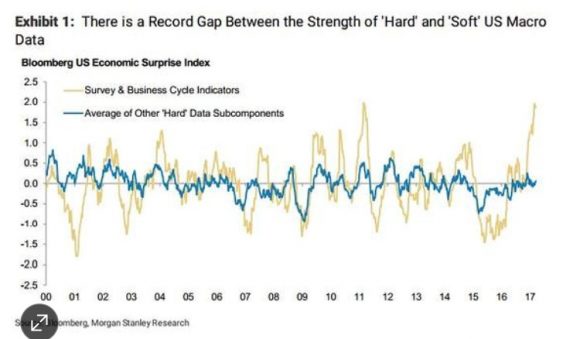It is the greatest conundrum facing traders, investors, and financial advisors today.
The recent "soft" economic data says the economy is booming, animal spirits are roaring, and the Trump trade is alive and well.
The "hard" data indicates that the economy is fading, fear and uncertainty are rampant, and you should sell everything immediately.
It is the greatest hard/soft divergence in the modern history of the US economy.
What's a poor investor to do?
Get this one right, and you'll make a killing. Get it wrong, and your portfolio will turn to ashes.
The numbers are undeniable.
"Soft" data comprises various poll-driven reports, such as consumer confidence and business surveys. These have been running.
The University of Michigan Consumer Sentiment Index hit a decade high in January and is up enormously YOY. Business surveys of every description are breaking records.
That "hard" data comprises economic reports that measure actual activity, such as retail sales.
These have not rebounded nearly as much as the soft data. Retail sales, housing sales, and the negative wealth effect of a falling stock market have all been turning in in-line or disappointing prints.
Here's a further complicating factor. Soft data is forward looking, while hard data is decidedly backward focused, often turning in numbers that are months old.
As a result, many private economic forecasters, and even different agencies of the US government are coming up with spectacularly diverging economic predictions based on the hard/soft weighting of their models.
The Federal Reserve Bank of New York's model, which gives more weight to the soft data, is currently projecting a 3% gross domestic product "print" this year.
On the other hand, the Federal Reserve Bank of Atlanta's model, which incorporates less soft data, is expecting only a 1% print.
You might as well throw a dart at the wall in a dive bar and pick a number.
Dig deeper into the numbers, and your conclusions can only become more disturbing.
It turns out that the overwhelming bulk of positive sentiment is coming from largely small businesses in red Trump-supporting states. They're clearly drinking the Kool-Aid.
You get almost the opposite result on the East and West Coasts, or in surveys that only look at Fortune 500 companies.
Eventually, only one group will be right. Either the hard data will catch up with the soft data, or it won't.
With November midterm elections getting closer by the day, with no new legislation passed this year, I believe the Trump trade will take MUCH longer to play out than expected.
In fact, a major economy-shifting bill may not pass at all this year.
So don't dump your stocks on pain of death. The bull market in stocks probably has at least another year to run.
Just don't expect too much excitement for the next several months.
Sell every rally AND buy every dip. This is what the pros are doing, with great success, as well as the followers of the Diary of a Mad Hedge Fund Trader.


Is This One Hard, Soft, or Both?


